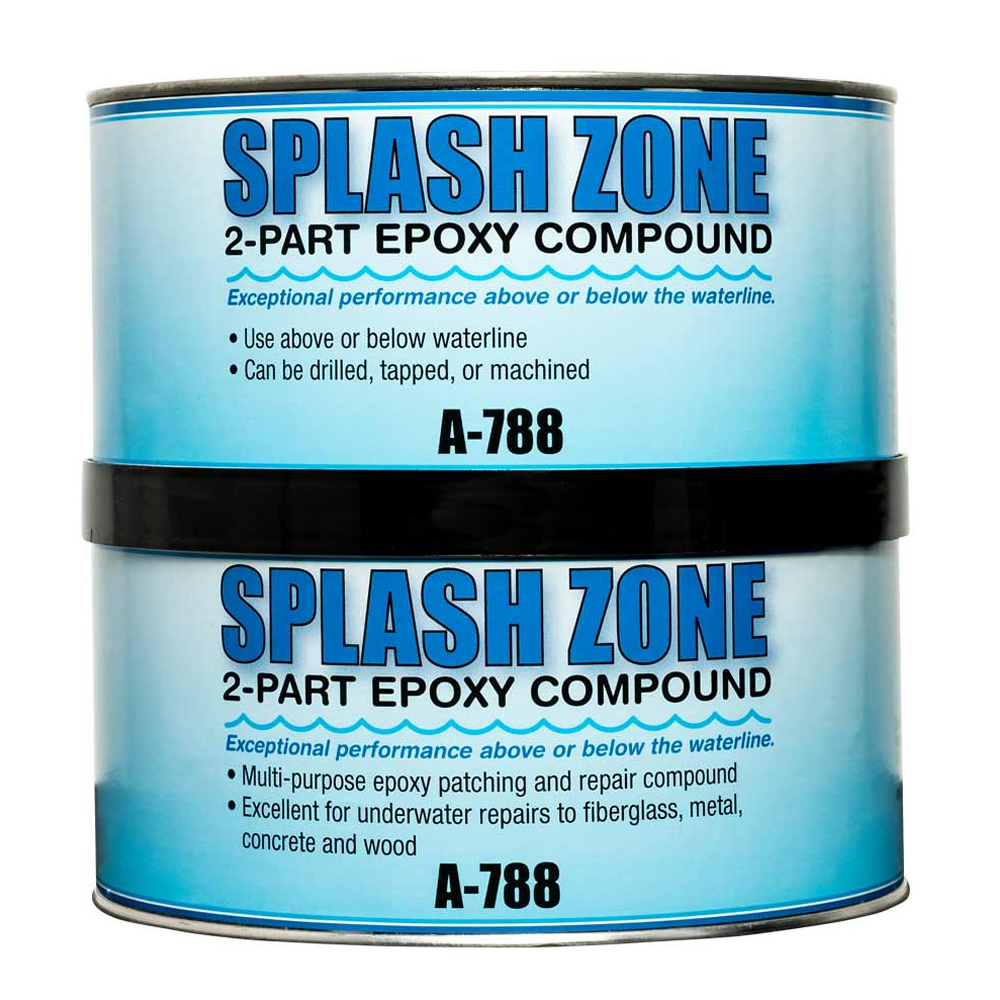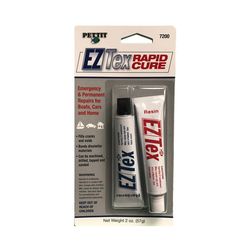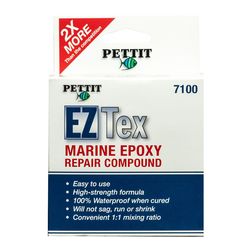The Splash Zone kit is Pettit's emergency repair solution. Utilizing Splash Zone Compound A-788, a two part 100 percent solids epoxy that applies like putty, Splash Zone seals, fills, patches or builds metals, wood, concrete, fiberglass and steel. It can be used to repair boat hulls, buoys, seawalls and docks. Pettit Emergency Repair Kit epoxy cures to an extremely hard coating which is abrasion and impact resistant.
The Pettit Emergency Repair Kit can repair aluminum, galvanized steel, fiberglass, steel, concrete and wood, both above and below the waterline.
USE
FOR MARINE USE ONLY. NOT INTENDED FOR USE IN THE HOME. A-788 Splash Zone Compound was originally designed to provide protection against corrosion of metals and erosion and deterioration of concrete and wood at, above and below the waterline in splash zones. It is used on steel or wood piling, and pier supports and as a coating repair of boat hulls and buoys and on any surface subject to erosion and corrosion in salt or fresh water. It is used for many patching and gouting applications that are not submerged, and on surfaces which subsequently are buried in soil.A-788 can be mixed and applied underwater and will cure underwater as well as in air. It adheres to any clean sound surface, either wet or dry, including aluminum, galvanized steel, steel, concrete, wood, fiberglass and existing coatings. It cures to an extremely hard coating which is abrasion and impact resistant, and which will substantially retard further erosion or corrosion.
A-788 is also solvent and chemical resistant when cured. It has been used as a grout and to patch perforated steel in tanks and pipelines holding mineral spirits, xylol (xylene), gasoline, acids, alkalis, hot water solutions (up to 160 deg F). Tanks must be clean and dry of their contents in order to use A-788. It will not cure properly in acidic or alkaline water solutions outside a pH range of 6 to 9, or in contact with solvents. Water pressure at a leak will push through A-788 before it cures; drain tank or relieve line plate or sheet of fiberglass, slightly larger than the hole, for additional support. Bed the support material in A-788, then coat with A-788.
Not for use in potable water.
TECHNICAL DATA
COMPONENTS : Two
NUMBER OF COATS : One
MINIMUM DRY THICKNESS: 1/8 inch (125 mils). Can be applied at up to 2 inches or greater thickness in one application as a grout, patch, surfacing material on horizontal surfaces, as a button patch on exposed bolt, threads, etc. (There is no change in thickness as A-788 cures because it is 100 percent non-volatile).
COVERAGE TO ACHIEVE MINIMUM DRY THICKNESS: 13 sq. ft./gallon (25 to 26 sq. ft. per gallon unit = two gallons total volume).
VOC : 0 lbs/gal
CURING TIME IN AIR OR WATER at 70 deg F : Begins to firm up within 2 hours; reaches full hardness in 6 to 8 hours. Curing is slower at lower temperatures. Will not cure and adhere properly at temperatures below 50 deg. F. Do not apply unless temperature will remain above 50 deg. F for at least 6 hours after application.
COLOR : Component A is yellow. Component B is black. The A and B mixture is olive green.
MIX RATIO : One part Component A; one part Component B by volume
POT LIFE (work time) AT 70 deg F (above or below water): Golfball size mix: 40 minutes maximum. Baseball to softball size mix: 30 minute maximum. 1/2 gallon (qt. kit) : 15 minutes maximum. Work time is reduced by 1/2 at temperature of 80 deg. F or higher. DO NOT mix more material than can be applied in the work times listed. Material may still be workable after work time limit has been exceeded, but it will not adhere properly after application and curing.
THINNER : Do not thin.
SURFACE PREPARATION
Remove all dirt, oil, grease, loose paint, rust, rotted and spalling concrete, rotted wood, marine growth and other interference materials. Adhesion of A-788 will only be as good as the cleanliness and soundness of the substrate. Sandblasting is preferred. High-pressure water blasting is acceptable. Scraping and other manual means of surface preparation are time consuming and of limited benefit. Sandblasting underwater can be done as the initial air blast will clear a patch through the water for the sand-air mixture. When working at splash zone or in salt water, coat cleaned metal surfaces as soon as possible to minimize new corrosion.
MIXING INSTRUCTIONS
Mix by hand. (Some people may be sensitive to epoxy or polyamide resins “ (wear tight fitting rubber gloves). Keep hands and material wet with water during mixing. Scoop a quantity of one component from can by hand. Scoop out an approximately equal quantity of the other component.
Mix and knead material by hand until the yellow and black components have combined to make uniform olive-green color. Apply immediately after mixing; no sweat-in time is required before using.
APPLICATION INFORMATION
Apply by hand. (Wear rubber gloves if sensitive to epoxy or polymide resins). If applying to dry surfaces in air, periodically rewet hands with water to facilitate application.
Spread smoothly on surface in 1/8 inch to 1/4 inch layer using heavy hand pressure to displace water and air bubbles. Smooth off by hand. When starting another handful, start spreading at and away from the previously applied film so as not to trap air bubbles or leave an area of uncoated surface. When used as a patch or grout, force material into hole or crack and smooth by hand to the thickness needed.
For marine applications in the splash zone, use all necessary safety precautions to protect the applicators. Wear wet suits if necessary to help preserve body heat; use life jackets and safety lines. Avoid working in excessively rough seas.
When applied underwater or when wetted with water during application, the surface of A-788 will form an emulsified lighter green scum layer. This is normal. The emulsified layer facilitates application. The film under the layer remains undisturbed and will cure properly. The layer will cure and most will become part of the finish if cured above water. The layer will remain soft and uncured if the A-788 is kept underwater during cure.
PRECAUTIONS : Follow precautions listed on a A-788 label.
![]() WARNING: Cancer - www.P65Warnings.ca.gov
WARNING: Cancer - www.P65Warnings.ca.gov
Reviews for Pettit Splash Zone Epoxy
Verified Purchase
Used the epoxy to repair crack on hull that was leaking into boat. Product is somewhat difficult work with because of its consistency but a video on Pettit and a little practice was very helpful. Leak fixed!!
Was this review helpful to you?
Verified Purchase
The epoxy is really tacky & sticky. I only used with gloves. I have only used above water. It easily stays in place, easy to control it from saggy, when used on vertical surface. I place several application on top of one another, after short dry time and also next day, on same repair. It is hard for me to tell if I have equal amount by placing amounts out side by side before mixing. Instruction say to mix in hand, but I mixed with a wooden paint stir stick on a piece of thick auto safety glass, mixing like you would mix auto fiberglass filler putty. ....... What I like most, is that I could smooth it out to where I would NOT have to use sand paper later. With glove still on, and putty still 'NOT' hardened, I would take my finger or thumb with water and rub the putty surface to where it became satisfactory smooth (for me). Add more water it putty starts to stick and pull from finger. Better than J B Weld Putty, but more sticky to work with. Repair of lower back transom. Very happy with final results.


Was this review helpful to you?
Verified Purchase
tough stuff, great for below water repairs.
Was this review helpful to you?
Verified Purchase
We had to cover an opening for a non-functional depth finder which was underwater and leaking. This required going under the boat and pressing upward, which we managed with a rope system. We pressed the goop over the area to be covered, and added another layer in about an hour. It set up within about a day, and the leak in the boat is now fixed.
Was this review helpful to you?
I used Splash Zone to repair my hull after hitting a reef in Fiji. It worked great, stuck to the hull great under water and was very durable. A must to have for any cruiser.
Was this review helpful to you?




